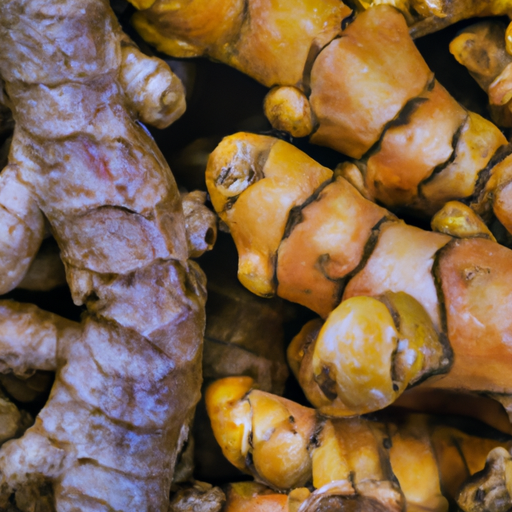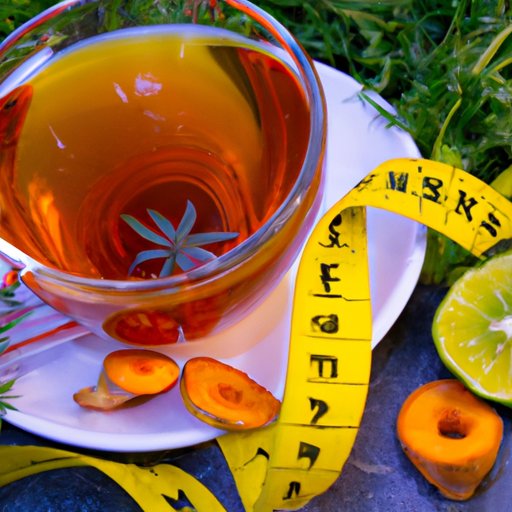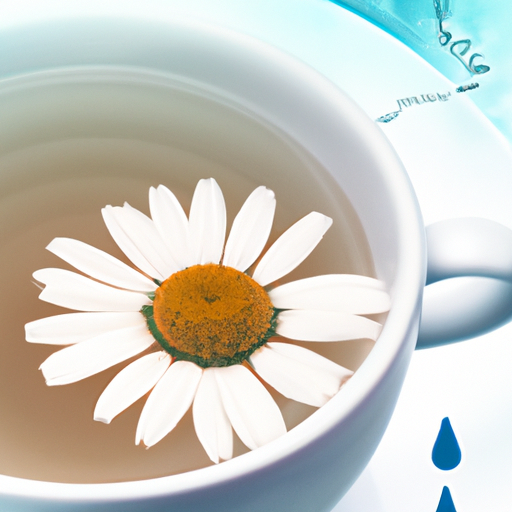As I sit here contemplating the vast array of spices and herbs that grace my kitchen shelves, one question stands out among the rest: which is better for reducing inflammation, ginger or turmeric?
These two aromatic powerhouses have been used for centuries in traditional medicine and cooking, each boasting its own unique set of healing properties. But when it comes to combating inflammation, which one reigns supreme?
Before we delve into the scientific evidence, let’s take a moment to appreciate the rich history and cultural significance of ginger and turmeric. Ginger, with its zesty flavor and warming qualities, has long been revered in Asian cultures for its medicinal benefits. Turmeric, on the other hand, hails from the vibrant lands of India and has been a staple in Ayurvedic medicine for centuries.
Now, let’s turn our attention to the active compounds that make these spices so potent. Ginger contains a compound called gingerol, which has been shown to possess anti-inflammatory properties. Turmeric, on the other hand, boasts curcumin, a powerful antioxidant known for its ability to reduce inflammation.
But what does the scientific evidence say? Which spice is truly the better anti-inflammatory agent? Join me as we explore the research, potential side effects, and ways to incorporate these spices into our diets. Together, we will uncover the truth and empower ourselves with the knowledge to make informed decisions about our health.
Key Takeaways
- Ginger and turmeric both have anti-inflammatory properties and offer a wide range of health benefits.
- Ginger is more effective in reducing acute inflammation, while turmeric may be more beneficial for chronic inflammation.
- Ginger extract reduces inflammation in conditions such as osteoarthritis and ulcerative colitis, comparable to nonsteroidal anti-inflammatory drugs (NSAIDs) but with fewer side effects.
- Turmeric, specifically its active compound curcumin, inhibits the activity of pro-inflammatory molecules and modulates the immune system, making it effective in reducing inflammation in conditions like rheumatoid arthritis and inflammatory bowel disease.
The Origins and Traditional Uses of Ginger and Turmeric
Did you know that both ginger and turmeric have been used for centuries in traditional medicine for their anti-inflammatory properties?
Ginger and turmeric have deep cultural significance in traditional medicine practices around the world. In many cultures, ginger is believed to have warming properties and is used to treat various ailments such as nausea, indigestion, and inflammation.
Turmeric, on the other hand, is widely used in Ayurvedic and traditional Chinese medicine for its anti-inflammatory and antioxidant properties.
When comparing the bioavailability of active compounds in ginger and turmeric, it’s important to note that both contain beneficial compounds such as gingerol in ginger and curcumin in turmeric.
However, the bioavailability of curcumin is relatively low, which means that the body may have difficulty absorbing and utilizing its therapeutic effects. On the other hand, gingerol in ginger has higher bioavailability, making it easier for the body to absorb and utilize its anti-inflammatory properties.
Transitioning into the subsequent section about the active compounds in ginger and turmeric, it’s interesting to explore how these compounds contribute to their overall anti-inflammatory effects.
The Active Compounds in Ginger and Turmeric
Not only do ginger and turmeric possess potent active compounds, but they also offer unique health benefits. Both herbs have been used for centuries in traditional medicine due to their anti-inflammatory properties. Ginger contains gingerol, a compound that has been shown to reduce inflammation in the body. It has also been found to have antioxidant effects, which can help protect against chronic diseases.
Turmeric, on the other hand, contains curcumin, which is known for its strong anti-inflammatory properties. Curcumin has been studied extensively for its potential to reduce inflammation and alleviate symptoms of conditions like arthritis and inflammatory bowel disease.
When it comes to comparing ginger and turmeric as natural remedies for inflammation, both have shown promising results. However, ginger has been found to be more effective in reducing acute inflammation, while turmeric may be more beneficial for chronic inflammation. Additionally, ginger has been found to have analgesic properties, meaning it can help alleviate pain associated with inflammation.
Ginger and turmeric each offer unique health benefits and can be effective natural remedies for inflammation. In the next section, we will explore the scientific evidence for the anti-inflammatory properties of ginger.
Scientific Evidence for the Anti-Inflammatory Properties of Ginger
You’ll be intrigued to learn about the scientific evidence supporting the powerful anti-inflammatory properties of ginger. Research on ginger’s effectiveness in reducing inflammation has shown promising results.
Several studies have demonstrated that ginger contains compounds called gingerols and shogaols, which have potent anti-inflammatory effects. These compounds work by inhibiting the production of inflammatory chemicals in the body, such as prostaglandins and leukotrienes.
Here are three key findings from the research:
-
A study published in the Journal of Medicinal Food found that ginger extract significantly reduced markers of inflammation in patients with osteoarthritis.
-
Another study published in the journal Phytotherapy Research showed that ginger supplementation reduced inflammation markers in people with ulcerative colitis.
-
A review published in the Journal of Natural Products concluded that ginger possesses anti-inflammatory properties comparable to nonsteroidal anti-inflammatory drugs (NSAIDs), but with fewer side effects.
When comparing ginger’s anti-inflammatory properties to other natural remedies, ginger has been found to be as effective or even more effective in reducing inflammation. It has been shown to be as effective as NSAIDs in some studies, and it is a natural alternative without the potential side effects.
Transitioning to the subsequent section about the scientific evidence for the anti-inflammatory properties of turmeric, it’s important to note that both ginger and turmeric have been extensively studied for their anti-inflammatory effects.
Scientific Evidence for the Anti-Inflammatory Properties of Turmeric
Turmeric’s remarkable ability to combat inflammation has been extensively documented, and its effectiveness is nothing short of astounding. Clinical trials have consistently shown that turmeric possesses powerful anti-inflammatory properties. In fact, a study published in the Journal of Alternative and Complementary Medicine found that turmeric extract was as effective as a widely used nonsteroidal anti-inflammatory drug (NSAID) in reducing inflammation in patients with knee osteoarthritis.
Other studies have also demonstrated turmeric’s efficacy in reducing inflammation in conditions such as rheumatoid arthritis and inflammatory bowel disease.
When comparing the anti-inflammatory properties of turmeric with other natural remedies, turmeric stands out as one of the most potent. Its active compound, curcumin, has been shown to inhibit the activity of several pro-inflammatory molecules in the body. Furthermore, turmeric has been found to modulate the immune system, reducing the production of inflammatory cytokines.
Transitioning into the subsequent section about potential side effects and precautions, it’s important to note that while turmeric is generally considered safe for most people, it can interact with certain medications and may cause digestive issues in high doses. Therefore, it’s always advisable to consult with a healthcare professional before incorporating turmeric into your daily regimen.
Potential Side Effects and Precautions
When considering the potential side effects and precautions of ginger and turmeric, it’s important to be aware of any possible risks.
Ginger may cause mild side effects such as heartburn, diarrhea, and stomach discomfort in some individuals.
Turmeric, on the other hand, may cause allergic reactions or interact with certain medications.
Therefore, it’s advisable to consult with a healthcare professional before incorporating these spices into your diet.
Ginger Side Effects
Although ginger has numerous health benefits, it’s important to be aware of the potential side effects it can cause. While ginger is generally safe for most people when consumed in moderate amounts, excessive intake or certain medical conditions can lead to side effects. Some common side effects of ginger include heartburn, stomach discomfort, diarrhea, and allergic reactions. It may also interact with certain medications, such as blood thinners, and should be avoided by individuals with bleeding disorders. However, these side effects are rare and usually only occur with high doses or prolonged usage. It’s always a good idea to consult with a healthcare professional before incorporating ginger into your routine, especially if you have any underlying health conditions or are taking medications. Moving on to turmeric side effects…
Turmeric Side Effects
Contrary to ginger’s potential side effects, turmeric also has its own set of possible adverse reactions that one should be aware of. When it comes to turmeric, the dosage plays a crucial role. While it’s generally considered safe when used in cooking or as a spice, consuming high doses or taking turmeric supplements may lead to gastrointestinal issues such as stomach upset, nausea, or diarrhea. It’s important to consult with a healthcare professional before starting any turmeric supplementation regimen.
Despite these potential risks, turmeric has shown promising benefits, including its anti-inflammatory properties and potential for improving cognitive function. Incorporating turmeric into your diet can be as easy as adding it to curries, soups, or even smoothies.
Now, let’s explore ways to incorporate both ginger and turmeric into your diet.
Ways to Incorporate Ginger and Turmeric into Your Diet
To incorporate ginger and turmeric into your diet, try adding them to your daily smoothies or sprinkling them on top of your favorite dishes. Both ginger and turmeric have numerous health benefits beyond their anti-inflammatory properties.
Ginger, known for its distinct flavor and aroma, has been used for centuries to aid digestion, reduce nausea, and relieve muscle pain.
Turmeric, on the other hand, contains a compound called curcumin, which has powerful antioxidant and anti-inflammatory effects.
There are many delicious recipes that can help you incorporate ginger and turmeric into your daily meals. For example, you can make a refreshing ginger and turmeric tea by steeping fresh ginger and turmeric in hot water. You can also add grated ginger and turmeric to stir-fries, soups, or marinades for an added kick of flavor and health benefits. Another option is to make a golden milk latte by combining turmeric, ginger, milk, and a touch of honey.
Both ginger and turmeric offer a wide range of health benefits beyond their anti-inflammatory properties. By incorporating these spices into your diet, you can enjoy their unique flavors and potentially improve your overall well-being.
With so many delicious ways to use ginger and turmeric in your daily meals, there’s no reason not to give them a try.
Now, let’s delve into the conclusion: which spice is the better anti-inflammatory agent?
Conclusion: Which Spice is the Better Anti-Inflammatory Agent?
After exploring various ways to incorporate ginger and turmeric into your diet, it’s time to address the burning question: which spice is the better anti-inflammatory agent?
When it comes to comparing the effectiveness of ginger and turmeric as pain relievers, both spices have shown promising results. Ginger contains compounds called gingerols, which possess anti-inflammatory properties that can help reduce pain and inflammation. On the other hand, turmeric contains curcumin, a powerful antioxidant with potent anti-inflammatory effects.
While both spices have their individual benefits, there is also potential for synergy when combining ginger and turmeric for anti-inflammatory purposes. Some studies suggest that the combination of these two spices may have a greater impact on reducing inflammation compared to using them separately. This is because they target different pathways in the body that contribute to inflammation.
However, it’s important to note that further research is needed to fully understand the specific mechanisms behind this potential synergy. Additionally, individual responses to these spices may vary, so it’s always advisable to consult with a healthcare professional before incorporating them into your anti-inflammatory regimen.
Both ginger and turmeric have demonstrated their effectiveness as anti-inflammatory agents. Whether used individually or in combination, these spices can be a valuable addition to your pain management routine.
Frequently Asked Questions
What are the potential side effects and precautions associated with consuming ginger and turmeric?
When consuming ginger and turmeric, it’s important to be aware of potential side effects and precautions. These include allergic reactions, digestive issues, and interactions with certain medications. It’s crucial to consult with a healthcare professional to understand the risks and drug interactions involved.
Are there any specific medical conditions or medications that may interact negatively with ginger or turmeric?
Interactions and contraindications can occur when ginger or turmeric are taken with certain medications or medical conditions. It is important to consult with a healthcare professional to understand any potential risks before incorporating these herbs into your routine.
Can ginger and turmeric be used together for enhanced anti-inflammatory effects?
Ginger and turmeric can be used together to enhance their anti-inflammatory effects. While there are no specific dosage recommendations, studies suggest that combining both can provide greater benefits due to their synergistic effects on inflammation.
Are there any differences in the way ginger and turmeric work as anti-inflammatory agents?
The ginger-turmeric combination has been praised as a super-duo for fighting inflammation, but how do they compare individually? Ginger and turmeric both have anti-inflammatory properties, but their effectiveness may vary depending on the specific condition and individual response.
How can ginger and turmeric be incorporated into a daily diet to maximize their anti-inflammatory benefits?
To maximize the anti-inflammatory benefits of ginger and turmeric, I incorporate them into my daily meals. I add ginger to smoothies, tea, and stir-fries, while turmeric is great in curry, roasted vegetables, and golden milk.
Conclusion
In conclusion, after analyzing the scientific evidence and traditional uses, it’s evident that both ginger and turmeric possess remarkable anti-inflammatory properties. However, it would be unfair to compare them and declare one as the superior spice. They each have their unique active compounds and health benefits.
It’s like comparing apples to oranges, as they both provide different flavors and nutritional value. Incorporating both ginger and turmeric into your diet can help support overall health and well-being. So, why not spice up your life with a combination of these powerful anti-inflammatory agents?










